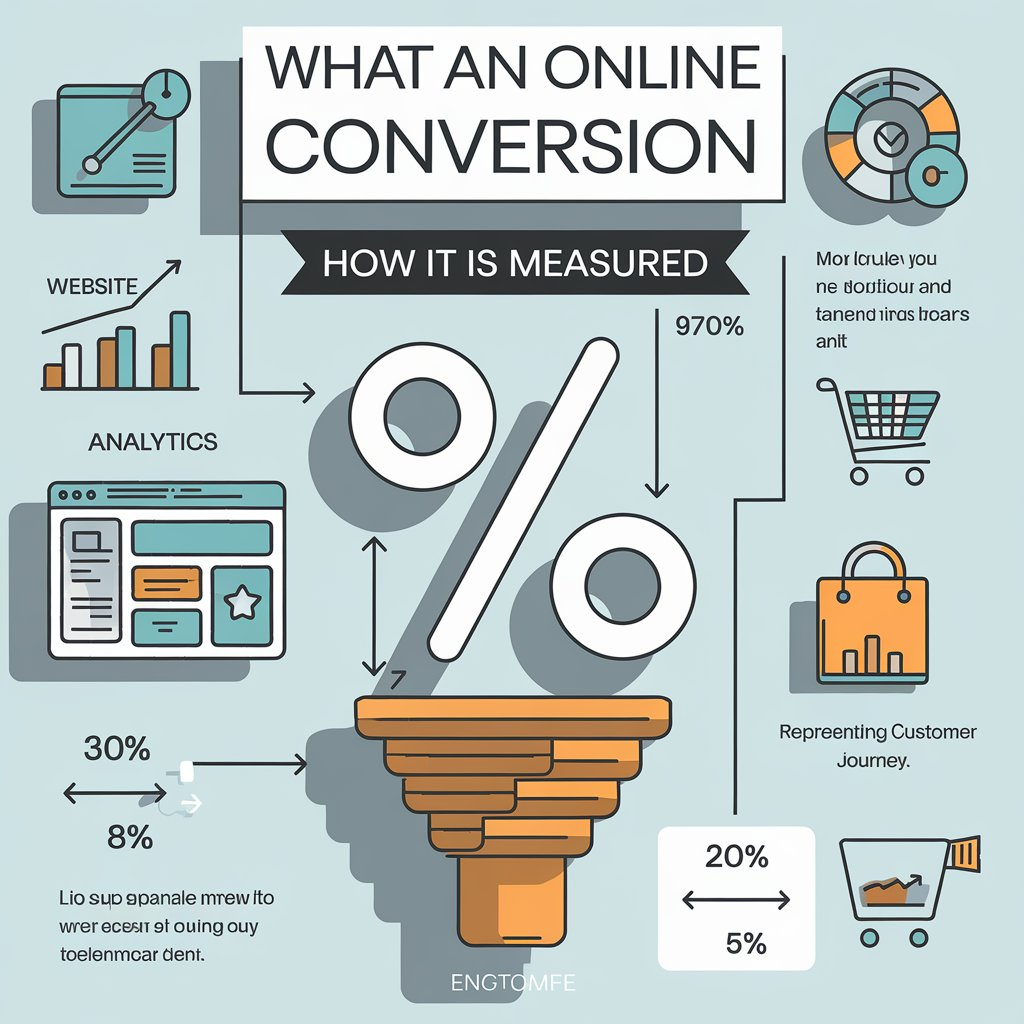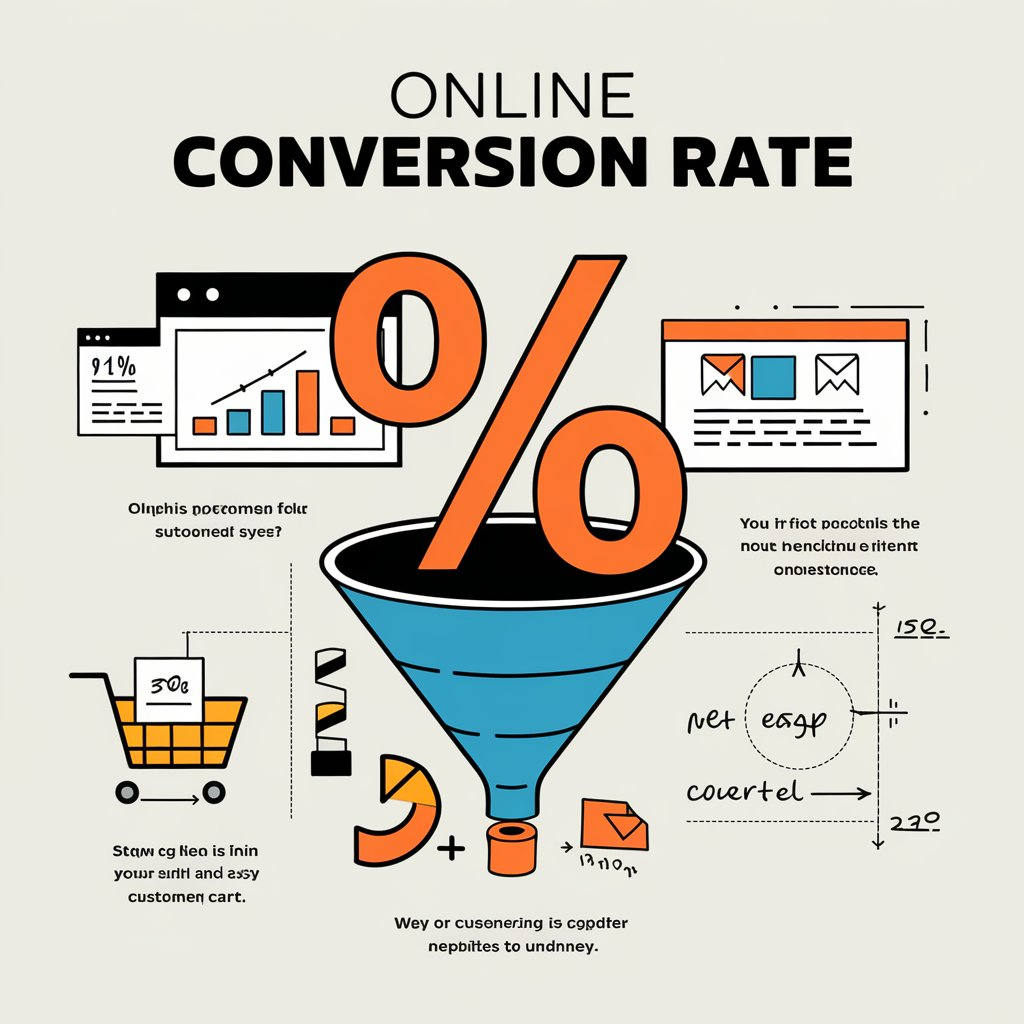What is an online conversion rate, and how is it measured?
In the digital world, success is often measured by numbers. One of these numbers is the online conversion rate. But what exactly is an online conversion rate? Simply put, it’s a metric that shows the percentage of website visitors who complete a desired action. This action could be anything from making a purchase to signing up for a newsletter.
Understanding and improving your online conversion rate is crucial. Why? Because it directly impacts your business’s bottom line. A higher conversion rate means more customers, more sales, and ultimately, more revenue. But how do you measure your online conversion rate? And more importantly, how can you improve it?

These are the questions we’ll be answering in this comprehensive guide. We’ll delve into the intricacies of online conversion rates, from their calculation to their optimization. We’ll also explore the tools you can use to track your conversion rates. And we’ll share strategies to help you boost your online store conversion rate.
Whether you’re a seasoned digital marketer or a small business owner, this guide will provide valuable insights. So, let’s dive in and demystify the world of online conversion rates.
Understanding Online Conversion Rates
Before we delve into the nitty-gritty, let’s start with the basics. What exactly is an online conversion rate? Why does it matter? And what are the different types of online conversions? Let’s find out.
What is an Online Conversion Rate?
An online conversion rate is a key performance indicator (KPI) in digital marketing. It measures the effectiveness of your website or online campaign. Specifically, it shows the percentage of website visitors who complete a desired action. This action is known as a “conversion.” But how do you calculate it?
The formula is simple: (Number of Conversions / Total Visitors) * 100%. For example, if your website had 100 visitors and 5 of them made a purchase, your conversion rate would be 5%.
Why Online Conversion Rates Matter
Online conversion rates are more than just numbers. They provide valuable insights into your website’s performance. A high conversion rate indicates that your website is effective at persuading visitors to take action. It means your website design, content, and user experience are aligned with your audience’s needs and expectations.
On the other hand, a low conversion rate suggests there’s room for improvement. It could mean that your website is not resonating with your audience. Or it could indicate technical issues, like slow page load times or broken links. In short, monitoring your online conversion rate can help you identify strengths and weaknesses in your online strategy.
Types of Online Conversions
Online conversions come in many forms. Here are some common examples of online conversions:
- Sales: This is the most straightforward type of conversion. It occurs when a visitor makes a purchase on your website.
- Sign-ups: This type of conversion happens when a visitor signs up for your newsletter, a free trial, or a membership.
- Downloads: If you offer downloadable content, such as an eBook or a whitepaper, a conversion occurs when a visitor downloads it.
- Form submissions: When a visitor fills out and submits a contact form, a conversion takes place.
Each type of conversion is valuable in its own way. Sales conversions directly generate revenue. Sign-ups and form submissions can lead to future sales by nurturing leads. And downloads can help establish your brand as an authority in your field. In the end, the types of conversions you track will depend on your business goals.
Measuring Online Conversion Rates
Now that we understand what an online conversion rate is, let’s discuss how to measure it. This involves using the right formula, choosing the right tools, and analyzing different conversion types. Let’s dive in.
The Basic Conversion Rate Formula
As mentioned earlier, the basic formula for calculating the online conversion rate is: (Number of Conversions / Total Visitors) * 100%. This formula is simple, yet powerful. It allows you to quantify the effectiveness of your website or online campaign.

However, it’s important to note that this formula only provides a high-level view. It doesn’t account for the nuances of different conversion types or the customer journey. For a more detailed analysis, you’ll need to use more advanced tools and techniques. Which brings us to our next point.
Tools for Tracking Conversion Rates
There are many tools available for tracking online conversion rates. Here are some of the most popular online conversion tools:
- Google Analytics: This free tool provides a wealth of data about your website traffic and conversions.
- Crazy Egg: This tool offers heatmaps and user recordings to help you understand how visitors interact with your website.
- Optimizely: This platform allows you to run A/B tests to identify the most effective elements for conversion.
- Hotjar: This tool provides visual analytics and user feedback tools to help you improve user experience and conversion rates.
- Unbounce: This platform helps you create and test landing pages to optimize conversions.
Each tool has its strengths and weaknesses. The best one for you will depend on your specific needs and budget. Remember, the goal is not to collect as much data as possible, but to collect the right data that will help you make informed decisions.
Analyzing Different Conversion Types
As we’ve discussed, there are many types of online conversions. Each type provides different insights and requires a different approach to analysis. For example, sales conversions can be analyzed in terms of revenue generated, average order value, and repeat purchase rate.
Sign-up conversions can be analyzed in terms of lead quality, lead source, and lead-to-customer conversion rate. Download conversions can be analyzed in terms of content engagement, content sharing, and follow-up actions. And form submission conversions can be analyzed in terms of response time, resolution rate, and customer satisfaction.
In each case, the goal is to understand not just how many conversions are happening, but why they are happening and how they can be improved. This requires a deep understanding of your audience, your website, and your business goals. In the next section, we’ll discuss benchmarks and industry standards for online conversion rates.
Benchmarks and Industry Standards
Understanding your online conversion rate is only half the battle. The other half is knowing how your rate compares to industry standards. This is where benchmarks come in. Benchmarks provide a point of reference against which you can measure your performance. They help you understand where you stand and where you need to improve. Let’s look at what constitutes a good online conversion rate and some industry-specific benchmarks.
What is a Good Online Conversion Rate?
A good online conversion rate can vary greatly depending on several factors. These include your industry, your target audience, and the type of conversion you’re measuring. However, as a general rule of thumb, a good online conversion rate is often considered to be around 2-5%.

Here are some factors that can influence your conversion rate:
- Website design: A well-designed website can significantly improve your conversion rate.
- User experience: A positive user experience can lead to higher conversion rates.
- Traffic quality: High-quality traffic (i.e., visitors who are interested in your offer) can result in higher conversion rates.
- Offer relevance: If your offer is relevant to your visitors, they are more likely to convert.
Remember, while it’s useful to aim for a high conversion rate, it’s more important to focus on the quality of your conversions. After all, attracting a lot of low-quality leads or making a lot of low-value sales won’t help your business in the long run.
Online Store Conversion Rate Benchmarks by Industry
When it comes to online stores, conversion rates can vary greatly by industry. Here are some average online store conversion rates by industry:
- Arts and Crafts: 3.3%
- Health and Wellbeing: 2.3%
- Home and Garden: 2.1%
- Fashion and Clothing: 1.8%
- Electronics: 1.4%
These figures are just averages, so your conversion rate could be higher or lower. Several factors can influence this, including your product range, pricing strategy, and competition level. The key is to continuously monitor your conversion rate and strive for improvement. In the next section, we’ll discuss some strategies for conversion optimization.
Conversion Optimization Strategies
Once you understand your online conversion rate and how it compares to industry benchmarks, the next step is to optimize. Conversion optimization is the process of improving your website and marketing strategies to increase the percentage of visitors who convert.
There are many strategies you can use to optimize your conversion rate. In this section, we’ll discuss five key areas: user experience, website design and navigation, call-to-action buttons, A/B testing, and mobile optimization.
Improving User Experience (UX)
User experience (UX) plays a crucial role in conversion optimization. A positive UX can make visitors more likely to convert, while a negative UX can drive them away.
Here are some ways to improve UX:
- Make your website easy to navigate.
- Ensure your website loads quickly.
- Use clear and concise language.
- Provide helpful and relevant content.
Remember, a good UX isn’t just about making your website look nice. It’s about creating a seamless and enjoyable experience that guides visitors towards conversion.
Website Design and Navigation
The design of your website can have a significant impact on your conversion rate. A well-designed website can make it easy for visitors to find what they’re looking for and guide them towards conversion. On the other hand, a poorly designed website can confuse visitors and make it difficult for them to convert.
Here are some tips for improving your website design and navigation:
- Use a clean and simple design.
- Make sure your navigation menu is easy to understand and use.
- Use clear and legible fonts.
- Use colors that align with your brand and are pleasing to the eye.
Remember, the goal of your website design should be to make it as easy as possible for visitors to convert.
Effective Call-to-Action (CTA) Buttons
Call-to-action (CTA) buttons are a crucial element of conversion optimization. They guide visitors towards the action you want them to take, whether it’s making a purchase, signing up for a newsletter, or downloading a resource.

Here are some tips for creating effective CTA buttons:
- Use action-oriented language.
- Make your CTA buttons stand out with contrasting colors.
- Keep your CTA text short and to the point.
- Place your CTA buttons where they’re easy to see.
Remember, your CTA buttons are the final push that encourages visitors to convert, so make them count!
A/B Testing for Conversion Optimization
A/B testing is a powerful tool for conversion optimization. It involves creating two versions of a webpage, email, or other marketing material and testing them against each other to see which performs better.
Here are some elements you might A/B test:
- Headlines
- Images
- CTA buttons
- Page layouts
By testing different elements, you can identify what works best for your audience and make data-driven decisions to improve your conversion rate.
Mobile Optimization
With more and more people using their mobile devices to browse the web and shop online, mobile optimization is more important than ever. A mobile-optimized website is not only more accessible to your audience, but it can also improve your conversion rate.
Here are some tips for mobile optimization:
- Make sure your website is responsive, meaning it adjusts to fit different screen sizes.
- Ensure your website loads quickly on mobile devices.
- Make your CTA buttons easy to tap on a small screen.
- Keep your mobile design simple and clutter-free.
Remember, a mobile-optimized website can provide a better user experience, which can lead to higher conversion rates.
Advanced Conversion Rate Tactics
Beyond the basic strategies, there are advanced tactics you can use to further optimize your conversion rate. These tactics involve a deeper understanding of your audience and their behavior on your website. In this section, we’ll discuss four advanced tactics: reducing bounce rates and cart abandonment, leveraging analytics for conversion insights, personalization and customer journey optimization, and retargeting and email marketing.
Reducing Bounce Rates and Cart Abandonment
Bounce rate refers to the percentage of visitors who leave your website after viewing only one page. A high bounce rate can indicate that visitors aren’t finding what they’re looking for or having a good experience on your website.
Here are some strategies to reduce your bounce rate:
- Improve your website’s load time.
- Make your content more engaging.
- Ensure your website is easy to navigate.
- Use a responsive design for mobile users.
Cart abandonment, on the other hand, occurs when a visitor adds items to their shopping cart but leaves before completing the purchase.
To reduce cart abandonment, you can:
- Simplify your checkout process.
- Offer multiple payment options.
- Provide clear and detailed product information.
- Offer free shipping or discounts.
By reducing your bounce rate and cart abandonment, you can keep visitors on your website longer and increase the chances of them converting.
Leveraging Analytics for Conversion Insights
Analytics tools can provide valuable insights into your visitors’ behavior and your website’s performance. These insights can help you identify areas for improvement and make data-driven decisions to optimize your conversion rate.

Here are some ways to leverage analytics for conversion insights:
- Track your conversion rate and other key performance indicators (KPIs).
- Analyze your website’s traffic sources to understand where your visitors are coming from.
- Use heatmaps to see where visitors are clicking and scrolling on your website.
- Conduct user testing to get qualitative feedback on your website.
Remember, analytics is not just about collecting data. It’s about interpreting that data and using it to improve your website and marketing strategies.
Personalization and Customer Journey Optimization
Personalization involves tailoring your website and marketing messages to meet the individual needs and preferences of your visitors. By providing a personalized experience, you can make your visitors feel valued and understood, which can increase their likelihood of converting.
Here are some ways to personalize your website and marketing:
- Use dynamic content to show different content to different visitors based on their behavior or characteristics.
- Send personalized emails based on a visitor’s past behavior or preferences.
- Use personalized product recommendations to show visitors products they might be interested in.
- Personalize your landing pages for different segments of your audience.
Customer journey optimization, on the other hand, involves understanding and optimizing the path that visitors take from first encountering your brand to converting. By optimizing the customer journey, you can guide visitors towards conversion and ensure they have a positive experience every step of the way.
Retargeting and Email Marketing
Retargeting involves showing ads to people who have previously visited your website or interacted with your brand. This can be a powerful way to re-engage visitors who didn’t convert on their first visit and remind them of what they’re missing out on.
Email marketing, on the other hand, involves sending emails to your subscribers to build relationships, provide value, and promote your products or services.
Here are some ways to use email marketing to increase your conversion rate:
- Send welcome emails to new subscribers to make a good first impression.
- Send promotional emails to announce sales or special offers.
- Send cart abandonment emails to remind visitors of items they left in their cart.
- Send personalized product recommendations based on a subscriber’s past behavior or preferences.
Remember, both retargeting and email marketing should be used as part of a larger marketing strategy. They can be powerful tools for driving conversions, but they should be used in conjunction with other strategies to achieve the best results.
Conversion Rate Optimization (CRO) Tools and Software
Conversion Rate Optimization (CRO) tools and software can help you analyze your website’s performance and identify opportunities for improvement. These tools can provide valuable insights into your visitors’ behavior, track your conversion rate, and test different elements of your website to see what works best. In this section, we’ll discuss some popular CRO tools and provide tips on how to choose the right CRO software for your needs.
Popular CRO Tools
There are many CRO tools available, each with its own features and benefits. Here are some of the most popular ones:
- Google Analytics: A free tool that provides detailed analytics about your website’s traffic and performance.
- Optimizely: A platform for A/B testing, multivariate testing, and personalization.
- Hotjar: A tool that provides heatmaps, session recordings, and user feedback to understand how visitors interact with your website.
- Unbounce: A landing page builder that allows you to create and test custom landing pages.
- Crazy Egg: A tool that provides heatmaps and A/B testing to understand what’s working on your website and what’s not.

Each of these tools has its own strengths and weaknesses, so it’s important to choose the one that best fits your needs and goals.
How to Choose the Right CRO Software
When choosing a CRO software, there are several factors to consider. First, consider your goals and what you hope to achieve with the software. Do you want to conduct A/B tests? And, do you need detailed analytics about your website’s performance? Do you want to create and test custom landing pages?
The answers to these questions can help guide your decision. Second, consider your budget. CRO software can range in price from free to several hundred dollars per month. Make sure to choose a software that fits within your budget while still providing the features you need. Third, consider the software’s ease of use.
Some CRO software can be complex and require a steep learning curve. If you’re new to CRO, you might want to choose a software that’s user-friendly and easy to learn. Finally, consider the software’s customer support. Good customer support can be invaluable when you’re trying to learn a new software or troubleshoot an issue.
Look for a software that offers reliable, responsive customer support. By considering these factors, you can choose a CRO software that will help you optimize your conversion rate and achieve your business goals.
Case Studies and Real-World Examples
Learning from real-world examples can be a great way to understand the impact of conversion rate optimization. In this section, we’ll look at some successful CRO campaigns and the lessons we can learn from them.
Successful Conversion Rate Optimization Campaigns
One successful CRO campaign was conducted by the online retailer, Zalando. They used A/B testing to optimize their product pages, resulting in a 10% increase in their conversion rate.
Another example is the online travel agency, Booking.com. They used personalization techniques to provide tailored recommendations to their users, which led to a significant increase in their conversion rate. These examples show that with the right strategies and tools, it’s possible to significantly improve your online conversion rate.
Lessons Learned from CRO Campaigns
There are several key lessons we can learn from these successful CRO campaigns. First, A/B testing is a powerful tool for optimizing your website. By testing different versions of your website, you can identify what works best and make data-driven decisions. Second, personalization can significantly improve your conversion rate.
By providing tailored content and recommendations, you can make your users feel valued and increase the likelihood of them making a purchase. Third, continuous optimization is key. The online landscape is constantly changing, and what works today might not work tomorrow. By continuously testing and optimizing your website, you can stay ahead of the curve and ensure your conversion rate remains high.

By applying these lessons, you can improve your own conversion rate and achieve your business goals.
Setting Goals and Expectations for Conversion Rates
Setting realistic goals is a crucial part of conversion rate optimization. It’s important to understand that while improving your conversion rate is beneficial, expecting to double or triple it overnight is unrealistic.
Realistic Conversion Rate Goals
A good starting point is to look at industry benchmarks. This can give you an idea of what a good conversion rate looks like in your industry. However, remember that these are just averages and your specific conversion rate can vary based on numerous factors.
Continuous Testing and Long-Term Optimization
Improving your conversion rate is not a one-time task. It requires continuous testing and optimization. Here are some key points to keep in mind:
- Regularly test different elements of your website.
- Use the data from these tests to make informed decisions.
- Don’t be afraid to try new strategies and techniques.
By setting realistic goals and committing to long-term optimization, you can steadily improve your conversion rate over time.
Conclusion and Next Steps
We’ve covered a lot of ground in this comprehensive guide on online conversion rates. From understanding what a conversion rate is, to measuring it, and then optimizing it, we’ve delved into the nitty-gritty of this crucial metric.
Recap of Key Takeaways
Remember, a good conversion rate is not just about the numbers. It’s about understanding your audience, providing value, and continuously optimizing your strategies.
Implementing Conversion Rate Optimization
честные казино с быстрыми выплатами
бездепозитные бонусы казино
играть в лучшем казино на деньги
база казино с бездепозитным бонусом
онлайн казино России
casino oyunu
Now, it’s time to put these strategies into action. Start by analyzing your current conversion rate, identify areas for improvement, and then implement the strategies we’ve discussed.

Remember, conversion rate optimization is a continuous process. Keep testing, keep learning, and keep improving.

